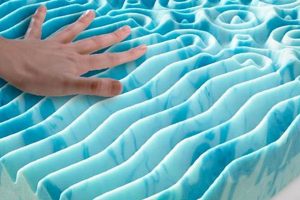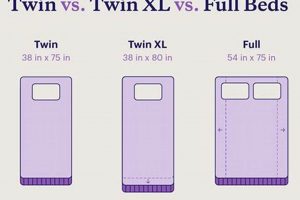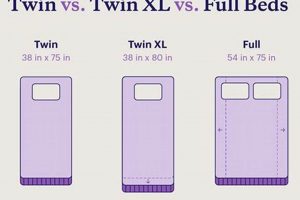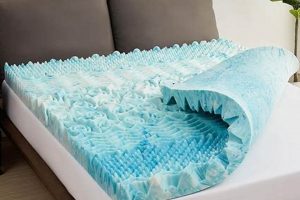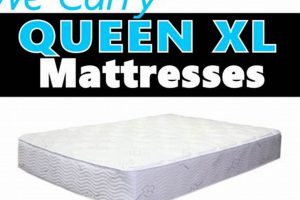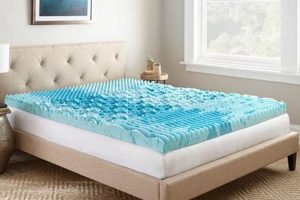A conforming bed accessory designed to fit a twin extra-long mattress, manufactured by Tempur-Pedic. These products are constructed from viscoelastic foam intended to improve sleep comfort and provide pressure relief. They are often utilized to modify the feel of an existing mattress, potentially enhancing its support or adding a softer surface.
The utilization of such items can significantly impact sleep quality by adapting a bed to individual comfort preferences. The visco elastic foam responds to body weight and temperature, molding to the user’s shape, and distributing pressure evenly. The brand has a history of pioneering memory foam technology, initially developed for NASA in the 1960s, leading to its subsequent adoption in bedding products.
The following sections will delve into the specific features, care guidelines, and considerations involved in selecting the appropriate viscoelastic foam enhancement for a twin extra-long bed. Understanding these elements will enable informed consumer decisions and optimize the sleeping experience.
Optimizing a Twin XL Viscoelastic Foam Bed Enhancer
The subsequent recommendations are designed to maximize the lifespan and effectiveness of a viscoelastic foam addition to a twin extra-long mattress. Proper care and usage are critical for realizing the intended benefits of such an investment.
Tip 1: Unpack and Air Out: Upon receipt, fully unwrap the product and allow it to air out in a well-ventilated space for at least 24 hours. This mitigates any residual odors from the manufacturing process and allows the foam to fully expand.
Tip 2: Utilize a Protective Cover: Always employ a fitted sheet or, preferably, a dedicated mattress protector designed for viscoelastic foam. This safeguards the surface from spills, stains, and general wear, prolonging the product’s lifespan.
Tip 3: Rotate Regularly: To ensure even wear and prevent indentations, rotate the item 180 degrees every three to six months. This helps distribute weight across the surface and maintain consistent support.
Tip 4: Spot Clean Only: Avoid machine washing or dry cleaning. If necessary, spot clean with a mild detergent and a damp cloth. Ensure the area is thoroughly dry before replacing bedding.
Tip 5: Avoid Direct Sunlight: Prolonged exposure to direct sunlight can degrade the foam’s structure and reduce its responsiveness. Position the bed away from direct sunlight or use window coverings to minimize exposure.
Tip 6: Maintain Adequate Support: Ensure the underlying twin extra-long mattress provides adequate support. An inadequate base can compromise the enhancer’s performance and contribute to premature wear.
Tip 7: Consider Room Temperature: Viscoelastic foam can be affected by ambient temperature. Extremely cold temperatures may cause it to feel firmer, while warmer temperatures can soften it. Maintaining a consistent room temperature can optimize performance.
Adhering to these guidelines will contribute to the longevity and sustained performance of the viscoelastic foam product, ultimately enhancing the sleeping experience.
The subsequent sections will address purchasing considerations and potential alternatives to viscoelastic foam enhancers.
1. Pressure Relief
The viscoelastic foam composition of a twin XL Tempur-Pedic mattress topper directly addresses the issue of pressure relief during sleep. Traditional innerspring mattresses often create concentrated pressure points, particularly at the hips, shoulders, and knees. These pressure concentrations can impede circulation, leading to discomfort, tossing and turning, and disrupted sleep patterns. The inherent property of viscoelastic foam is its ability to conform to the body’s contours, distributing weight evenly across the surface. This redistribution minimizes pressure point formation, allowing for improved blood flow and reduced musculoskeletal strain. For example, an individual with arthritis or fibromyalgia may experience significantly less pain and improved sleep quality as a result of the pressure-relieving qualities.
The effectiveness of pressure relief varies based on the density and thickness of the viscoelastic foam. Higher density foam generally provides more substantial support and pressure distribution, while thicker designs offer greater cushioning. Furthermore, the Tempur-Pedic formulation, developed from NASA technology, is specifically engineered for optimal pressure reduction compared to generic memory foam alternatives. This is achieved through a unique open-cell structure that responds more sensitively to body temperature and weight, creating a truly personalized sleeping surface. Individuals who spend prolonged periods in bed due to illness or limited mobility especially benefit from the enhanced pressure relief, reducing the risk of pressure sores and improving overall comfort.
In summary, pressure relief is a fundamental attribute of a twin XL Tempur-Pedic mattress topper, driven by its viscoelastic foam construction and design. The ability to distribute body weight evenly reduces concentrated pressure points, fostering improved circulation, reduced discomfort, and enhanced sleep quality. While density and thickness influence the degree of pressure relief, the specific Tempur-Pedic formulation offers unique advantages. Understanding this connection allows consumers to make informed decisions when selecting bedding solutions aimed at optimizing sleep comfort and mitigating pressure-related discomfort.
2. Size Conformity
Size conformity is a defining characteristic that dictates the effectiveness of a twin XL Tempur-Pedic mattress topper. A precise fit is paramount; a product that is too small will leave sections of the mattress uncovered, negating the intended pressure relief and comfort benefits. Conversely, an oversized item will bunch, fold, or slip, creating an uneven sleeping surface and potentially causing discomfort or safety hazards. The designated “twin XL” size, adhering to standardized dimensions of approximately 38 inches wide by 80 inches long, is crucial for proper alignment. Without this dimensional accuracy, the ergonomic properties are compromised, and the investment loses value. For instance, a user might purchase such an item seeking relief from back pain, but if the dimensions are off, the support is inconsistent, failing to address the underlying need.
The manufacturing precision of Tempur-Pedic is central to achieving optimal size conformity. Substandard manufacturing tolerances can lead to variations in dimensions, even within the specified “twin XL” range. These variations can result in a product that is either too tight, making it difficult to install and potentially damaging the existing mattress, or too loose, leading to undesirable movement during sleep. Furthermore, inconsistencies in size directly affect the performance of fitted sheets and mattress protectors. Sheets designed for a true twin XL mattress may not fit properly on a poorly sized product, potentially creating further discomfort and inconvenience. This highlights the importance of verifying the advertised dimensions and selecting products from reputable manufacturers known for their adherence to size standards.
In conclusion, size conformity is not merely a superficial attribute but an essential element directly impacting the functionality and value of a twin XL Tempur-Pedic mattress topper. A precise fit is critical for ensuring uniform pressure relief, preventing discomfort, and facilitating compatibility with other bedding accessories. Variations in dimensions stemming from manufacturing inconsistencies can negate the intended benefits. Therefore, careful attention to size specifications and selection of products from trusted manufacturers are paramount for maximizing the investment and achieving optimal sleep comfort.
3. Material Density
Material density, measured in pounds per cubic foot (PCF), is a critical determinant of the performance and longevity of a viscoelastic foam enhancement for a twin XL bed. Higher density indicates a greater concentration of material within a given volume, directly impacting the support, durability, and overall feel. A denser product, for example, provides more resistance to compression, offering superior support for heavier individuals or those with specific postural needs. The enhanced resistance also translates to a longer lifespan, as the material is less prone to deformation and breakdown over time. Conversely, a lower density composition will exhibit less resistance to compression, potentially bottoming out under weight and exhibiting premature wear. The purchase of a low-density item, while possibly initially more economical, may necessitate more frequent replacements, offsetting any initial cost savings.
The effect of material density extends beyond support and durability to influence thermal properties. Denser viscoelastic foam tends to retain more heat, which can be a consideration for individuals who sleep hot. However, manufacturers often incorporate open-cell structures or gel infusions to mitigate this heat retention. Material density also impacts the product’s ability to conform to body contours. While all viscoelastic foam is designed to contour, higher density compositions may initially feel firmer, requiring a break-in period before fully adapting to the user’s shape. The decision to prioritize higher or lower density depends on individual preferences and requirements, but understanding its effects is crucial for making an informed choice. Consider, for example, a lightweight individual who prefers a softer sleeping surface; a lower-density option may provide the desired level of plushness without sacrificing support.
In summary, material density is a fundamental characteristic dictating the support, durability, thermal properties, and overall feel of a viscoelastic foam product for a twin XL bed. The choice between higher and lower densities depends on individual weight, sleep preferences, and thermal considerations. Recognizing the implications of material density allows consumers to align their purchase with their specific needs and expectations, ultimately optimizing the sleeping experience. Failure to account for this attribute can lead to dissatisfaction and premature product failure, undermining the intended benefits.
4. Heat Dissipation
Heat dissipation is a critical attribute that directly impacts the comfort and usability of a viscoelastic foam enhancement for a twin XL mattress. Viscoelastic foam, by its nature, can possess a tendency to retain body heat due to its dense structure and limited airflow. This heat retention can create an uncomfortable sleeping environment, leading to restlessness, night sweats, and disrupted sleep, particularly for individuals who are naturally warm or who live in warmer climates. The design and materials utilized in a twin XL Tempur-Pedic mattress topper must therefore address this inherent characteristic to ensure a comfortable and restful sleep experience. For example, without adequate heat dissipation features, a user may find the product uncomfortably warm, negating the pressure-relieving benefits and diminishing overall sleep quality. This necessitates the incorporation of strategies to improve airflow and reduce heat accumulation.
Several approaches are employed to enhance heat dissipation in viscoelastic foam products. One common technique involves the incorporation of open-cell structures within the foam itself. These open cells create channels for air to circulate, allowing heat to dissipate away from the body. Gel infusions, another prevalent method, involve embedding gel particles within the foam matrix. These gel particles possess a higher thermal conductivity than the surrounding foam, facilitating heat transfer and promoting a cooler sleeping surface. Furthermore, some products utilize specialized fabrics for the outer cover that are designed to wick away moisture and enhance breathability. The effectiveness of these heat dissipation mechanisms can vary significantly depending on the specific design and materials used, and consumer reviews often provide insights into real-world performance. A failure to adequately address heat dissipation can result in a product that is perceived as uncomfortably warm, regardless of its other beneficial properties.
In summary, heat dissipation is a crucial factor to consider when evaluating a viscoelastic foam addition for a twin XL bed. The inherent heat-retentive properties of viscoelastic foam necessitate the incorporation of design features such as open-cell structures, gel infusions, and breathable fabrics to mitigate heat accumulation and promote a comfortable sleeping environment. The effectiveness of these features directly impacts the usability and perceived value of the product, and consumer reviews often provide valuable information regarding real-world performance. Neglecting this aspect can lead to dissatisfaction and negate the intended benefits, even if other aspects of the design are well executed. Therefore, careful consideration of heat dissipation mechanisms is essential for making an informed purchase and optimizing sleep quality.
5. Supportiveness
Supportiveness, in the context of a twin XL Tempur-Pedic mattress topper, refers to its ability to maintain spinal alignment, distribute body weight evenly, and provide a stable sleep surface. It is a key factor in determining the overall comfort and ergonomic benefits.
- Spinal Alignment and Posture
A supportive product contributes to proper spinal alignment, preventing the development or exacerbation of back pain. This is achieved by filling the gaps between the body and the mattress, providing consistent support along the length of the spine. For example, a side sleeper requires adequate support to prevent the spine from curving downwards, while a back sleeper benefits from support that maintains the natural lumbar curve. A lack of adequate support may result in poor posture during sleep, leading to stiffness and discomfort.
- Weight Distribution and Pressure Relief
Supportiveness is intrinsically linked to weight distribution. A product that effectively distributes weight reduces pressure points, particularly at the hips and shoulders. This is vital for promoting circulation and preventing the development of pressure sores. The support provided needs to be consistent across the entire surface to prevent sagging or unevenness, which can compromise weight distribution. For instance, an individual with a higher body mass index requires a more supportive material to prevent sinking too deeply into the bed.
- Edge Support and Stability
Edge support refers to the firmness and stability along the perimeter of the enhancement. Adequate edge support allows individuals to sit or lie near the edge of the bed without experiencing significant compression or roll-off. This is especially important for individuals with mobility issues or those who share the bed with a partner. A lack of edge support can make it difficult to get in and out of bed and reduce the usable sleeping surface area. Stronger edge support generally contributes to a more stable and secure feeling overall.
- Density and Material Composition
The density and composition of the viscoelastic foam directly impact supportiveness. Higher-density foams offer greater resistance to compression and tend to provide more robust support. The specific formulation of the foam, including the presence of gel infusions or other additives, can also influence its ability to provide consistent and conforming support. Over time, the material’s ability to maintain its supportiveness is a critical factor in its long-term value.
These facets of supportiveness are essential when evaluating a twin XL Tempur-Pedic mattress topper. A product that effectively addresses spinal alignment, weight distribution, edge support, and utilizes appropriate material density will contribute to a comfortable and ergonomically sound sleeping environment. A compromise in any of these areas can reduce the product’s effectiveness and overall value.
Frequently Asked Questions
The subsequent questions address common inquiries regarding viscoelastic foam bed enhancements designed for twin extra-long mattresses. These answers aim to provide clarity and facilitate informed consumer decisions.
Question 1: What is the expected lifespan of a twin XL Tempur-Pedic mattress topper?
The lifespan of a viscoelastic foam enhancement varies depending on usage, care, and material density. Generally, one can anticipate a lifespan of 3-7 years with proper care. Higher density formulations tend to exhibit greater longevity.
Question 2: Can a twin XL Tempur-Pedic mattress topper alleviate back pain?
The pressure-relieving properties of viscoelastic foam may contribute to a reduction in back pain by promoting spinal alignment and reducing pressure points. However, the effectiveness varies depending on the individual’s condition and the severity of the pain. Consultation with a healthcare professional is recommended for persistent back pain.
Question 3: How should a twin XL Tempur-Pedic mattress topper be cleaned?
Spot cleaning with a mild detergent and a damp cloth is recommended. Machine washing or dry cleaning is generally not advised, as it can damage the viscoelastic foam structure. Ensure the area is thoroughly dry before replacing bedding.
Question 4: Does a twin XL Tempur-Pedic mattress topper require a special type of sheet?
Standard twin XL sheets are generally compatible. However, fitted sheets with deep pockets may be necessary to accommodate the added height. A mattress protector is recommended to safeguard the surface from spills and stains.
Question 5: Will a twin XL Tempur-Pedic mattress topper make the bed warmer?
Viscoelastic foam can retain heat. However, many products incorporate open-cell structures or gel infusions to mitigate heat retention. Consider these features if overheating is a concern.
Question 6: How does material density affect the performance of a twin XL Tempur-Pedic mattress topper?
Higher density generally translates to greater support, durability, and resistance to compression. However, it can also result in a firmer initial feel. Lower density compositions offer a softer feel but may be less durable.
Understanding the expected lifespan, care requirements, and potential benefits of a viscoelastic foam enhancement is crucial for making an informed purchase. Material density and heat dissipation properties should be carefully considered.
The following section will address alternative bed enhancement options and their respective characteristics.
Conclusion
This examination has explored key attributes of a twin XL Tempur-Pedic mattress topper, including pressure relief, size conformity, material density, heat dissipation, and supportiveness. Understanding these characteristics allows for informed purchasing decisions, aligning individual needs with specific product features. Proper maintenance and usage directly impact the product’s lifespan and effectiveness.
The selection of a sleeping surface enhancement requires careful consideration of individual preferences and physical requirements. Weighing the benefits against potential drawbacks ensures an optimal investment. Continued research and technological advancements may yield further improvements in viscoelastic foam formulations, potentially enhancing both comfort and durability in the future.


